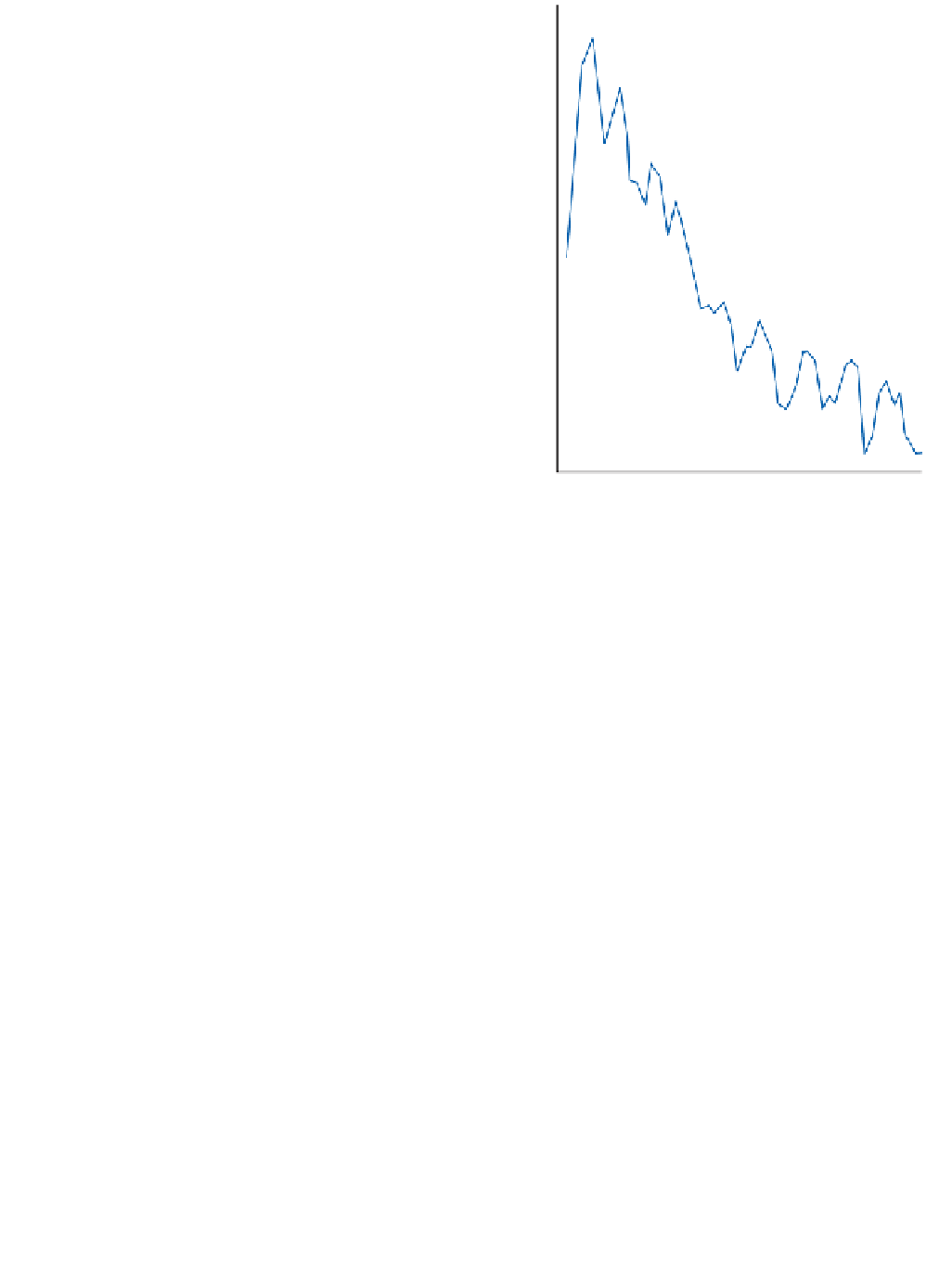Geoscience Reference
In-Depth Information
between the two hemispheres. Aphelion in the northern
hemisphere will produce cooler winters but the summer
perihelion should give warmer summers, increasing the
seasonal difference in temperature. We also find that the
degree of ellipticity of Earth's orbit changes through time
over a cycle of about 96,000 years; this phenomenon is
known is the
eccentricity of the orbit
. At times the orbit
is almost circular and there is little difference in input
between perihelion and aphelion; 47,500 years later the
orbit is at its most elliptical, with a strong difference
between perihelion and aphelion. This variation affects
the amount of solar radiation intercepted by Earth by a
small amount.
The final source of variation in the distribution of
solar inputs is the changes in the tilt of Earth's axis of
rotation. Although, at present, the tilt is about 23·5
, it can
range from 21·8
100,000 yrs
43,000 yrs
24,000 yrs
19,000 yrs
. This means that the precise
latitude of our tropics will shift slightly. When the axis has
a greater tilt, the position of the overhead sun at midday
at the solstices is further polewards by about 2·5
to 24·4
than
when the tilt is smallest. This produces greater seasonal
contrast with high tilt and less contrast with a small tilt.
The variation is sometimes referred to as the
obliquity of
the ecliptic
, or more simply as the variation in tilt, and
takes place over a full cycle of approximately 41,000 years.
The impact of the variations in the solar radiation due
to orbital changes varies with latitude. In high latitudes it
is the 41,000 year cycle which dominates, whilst at lower
latitudes the 22,000 year cycle is dominant. From the
amounts of incoming radiation, with an allowance for ice
cover, calculations of Earth's energy budget indicate that
the orbital variations have the correct timing and size to
start the succession of major advances and retreats of the
ice sheets during the last 300,000 years. This is seen most
clearly in some of the ocean cores, where undisturbed
sediments have accumulated over thousands of years.
Fluctuations in temperature are determined from their
fossil and carbonate contents and do show strong links
with the Milankovich cycles (
Figure 9.12
).
However, the
graph shows that it is the longest cycle - the eccentricity
- which produces the dominant signal in the sediments,
despite the fact that it causes only small variations in global
solar radiation compared with the other two factors.
There are a number of other problems when trying to
link orbital parameters with the oceanic and ice core
records. According to Milankovich, the eccentricity peak
should be split into two elements with periods of 95,000
and 125,000 years, but the data indicate a single narrow
peak. Global ice indications are that prior to 1 M years ago,
ice volume was dominated by the obliquity signal, but
thereafter the eccentricity signal has become dominant.
100
30
15
10
7.5
6
Cycle length (thousands of years)
half-million years. This graph - showing the relative impor-
tance of different orbital cycles in the isotope record of two
Indian Ocean cores - confirmed many predictions of the
Milankovitch theory.
Source: After Imbrie and Imbrie (1979)
As yet we are unable to explain this feature. Again, in the
global ice the precession component is consistently small;
the signal is dominated by obliquity for reasons we cannot
explain. Finally there is the problem that orbital processes
change slowly, whilst there is frequent evidence from
sediments that changes of climate, especially Ice Age
termination, can take place rapidly (
Figure 9.13
and box,
p. 179). For example, in one deposit near Birmingham
(UK) a typical northern assemblage of beetles was found
dated to 10,025 ± 100 years
BP
. Ten centimetres higher no
Arctic fauna survived at an age of 9,970 ± 110 years
BP
.
Conversely the rapid cooling at about 10,900
BP
brought
a catastrophic readvance of the ice, which destroyed fully
grown forests, and caused desiccation in Colombia and a
marked cooling in Antarctica within a time span of only
200-300 years. Ice cores from Greenland have also
confirmed rapid changes within the last glacial period.
The ending of the Younger Dryas period could have taken
only ten to twenty years, with a temperature increase of
7
C and an increase of precipitation of 50 per cent.
Such rapid temperature oscillations - and there are many
others recorded in the ice cores - are now known as
Dansgaard-Oeschger events. It seems highly unlikely that




















































